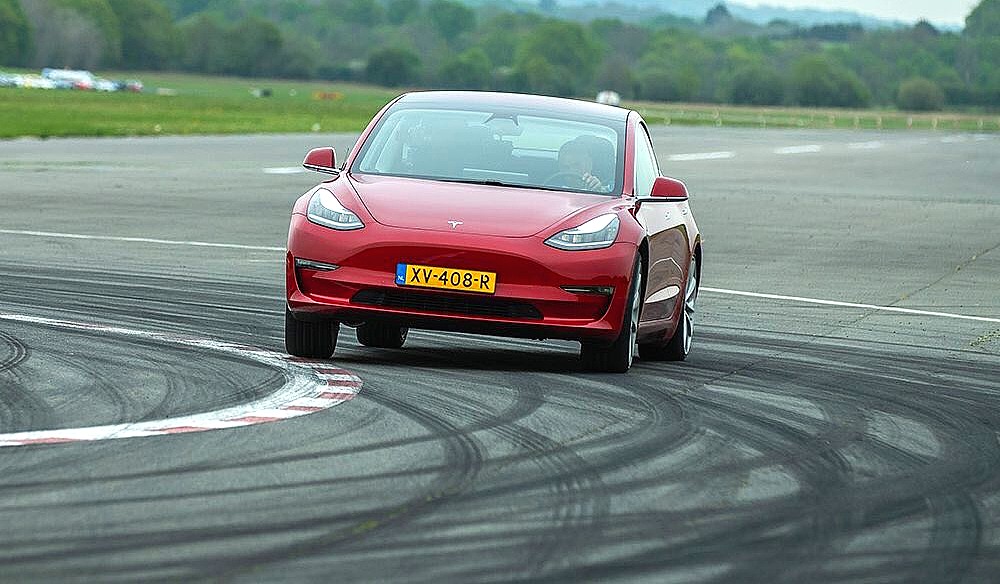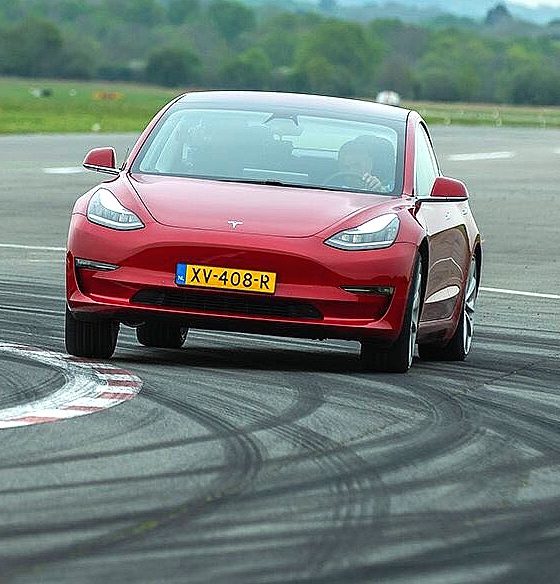

News
Tesla gets full ‘Top Gear’ treatment, Chris Harris to buy Model 3 ‘soon’ after review
There was once a time when UK-based auto show Top Gear practically ignored the existence of Tesla vehicles on the car market. If the popular motoring program’s recent episode is any indication, that time appears to be long gone. The auto show’s host, Chris Harris, has become somewhat of an EV convert during his time with the all-electric sedan.
Off the bat, Harris noted that he would try his best to ignore the hype surrounding the Model 3. He stressed the importance of simply reviewing the vehicle the same way he does other cars. For the most part, he did, discussing only the vehicle’s characteristics such as its suite of fun Easter Eggs, its minimalistic interior, and its exterior looks. The Top Gear host was unimpressed with the Model 3’s design, finding the car to be far too “vanilla” for a vehicle that is being considered as an automobile that can change the face of motoring forever.
But then, the host quips, perhaps that was the point of the Model 3. Tesla made it a point to ensure that its most disruptive vehicle to date does not shock and awe at face value. Being a great car that just so happens to be electric, Harris noted that the Model 3 does appear to have what it takes to convert people away from the veterans of Europe’s hot high-performance sedan market.
And then came the track test.
Gunning the electric sedan into a track, the host could be seen genuinely enjoying the vehicle. The motiring show opted to test the Model 3 against the best high-performance sedans that Europe can offer: the Mercedez-AMG C 63 S, the BMW M3, and the Alfa Romeo Giulia Quadrifoglio. First off was a drag race, an event that the Model 3 would likely dominate.
In order to give the vehicle a bigger challenge, the motoring show opted to hold a half-mile race. As the four-way race started, Harris was surprised when the Model 3 just kept pulling, even beyond the quarter-mile mark. The Mercedes-AMG C 63 S did catch the Model 3 a few feet away from the half-mile mark, but even with this result, the Top Gear host was convinced.
“This is the traffic light king. It’s an AK-47 disguised as a butter knife,” Harris said as he contemplated the results of the half-mile drag race.
Perhaps what really convinced Harris was the results of the Model 3’s handling test, which required the vehicle to go around a hastily-assembled course. The Top Gear host previously drove both the M3 and the Giulia Quadrifoglio on the same course, and the Alfa Romeo ended up winning against the BMW. With this in mind, Harris opted to set the time using the powerful petrol sedan. The Alfa Romeo lived up to its reputation, handling the track in a refined manner, and completing the course in 1:04:84.
The Top Gear host was not a fan of the Model 3’s handling, stating that the vehicle felt soft around the corners. It was unknown if the electric sedan’s Track Mode was activated during the test, but the Tesla nonetheless attacked the course with such ferocity that Harris was nevertheless impressed. While the Model 3 was not as refined around the corners as the Giulia Quadrifoglio, the vehicle’s insane acceleration was nonetheless enough to complete the course in 1:04:28, a full half-second faster than the Alfa Romeo. Considering that the Model 3 seemed to have only 50+% of its battery during the tests, these figures are nonetheless impressive.
The motoring show ended its Tesla segment by concluding that the Model 3 does indeed live up to Elon Musk’s statements. It does beat petrol cars, even around the track. For a show like Top Gear to admit such a thing, is not a bad accomplishment for the Model 3 at all. As for Chris Harris, he recently announced on Twitter that he has decided to buy a Tesla Model 3 for himself.

News
Tesla FSD fleet is nearing 7 billion total miles, including 2.5 billion city miles
As can be seen on Tesla’s official FSD webpage, vehicles equipped with the system have now navigated over 6.99 billion miles.

Tesla’s Full Self-Driving (Supervised) fleet is closing in on almost 7 billion total miles driven, as per data posted by the company on its official FSD webpage.
These figures hint at the massive scale of data fueling Tesla’s rapid FSD improvements, which have been quite notable as of late.
FSD mileage milestones
As can be seen on Tesla’s official FSD webpage, vehicles equipped with the system have now navigated over 6.99 billion miles. Tesla owner and avid FSD tester Whole Mars Catalog also shared a screenshot indicating that from the nearly 7 billion miles traveled by the FSD fleet, more than 2.5 billion miles were driven inside cities.
City miles are particularly valuable for complex urban scenarios like unprotected turns, pedestrian interactions, and traffic lights. This is also the difference-maker for FSD, as only complex solutions, such as Waymo’s self-driving taxis, operate similarly on inner-city streets. And even then, incidents such as the San Francisco blackouts have proven challenging for sensor-rich vehicles like Waymos.
Tesla’s data edge
Tesla has a number of advantages in the autonomous vehicle sector, one of which is the size of its fleet and the number of vehicles training FSD on real-world roads. Tesla’s nearly 7 billion FSD miles then allow the company to roll out updates that make its vehicles behave like they are being driven by experienced drivers, even if they are operating on their own.
So notable are Tesla’s improvements to FSD that NVIDIA Director of Robotics Jim Fan, after experiencing FSD v14, noted that the system is the first AI that passes what he described as a “Physical Turing Test.”
“Despite knowing exactly how robot learning works, I still find it magical watching the steering wheel turn by itself. First it feels surreal, next it becomes routine. Then, like the smartphone, taking it away actively hurts. This is how humanity gets rewired and glued to god-like technologies,” Fan wrote in a post on X.
News
Tesla starts showing how FSD will change lives in Europe
Local officials tested the system on narrow country roads and were impressed by FSD’s smooth, human-like driving, with some calling the service a game-changer for everyday life in areas that are far from urban centers.

Tesla has launched Europe’s first public shuttle service using Full Self-Driving (Supervised) in the rural Eifelkreis Bitburg-Prüm region of Germany, demonstrating how the technology can restore independence and mobility for people who struggle with limited transport options.
Local officials tested the system on narrow country roads and were impressed by FSD’s smooth, human-like driving, with some calling the service a game-changer for everyday life in areas that are far from urban centers.
Officials see real impact on rural residents
Arzfeld Mayor Johannes Kuhl and District Administrator Andreas Kruppert personally tested the Tesla shuttle service. This allowed them to see just how well FSD navigated winding lanes and rural roads confidently. Kruppert said, “Autonomous driving sounds like science fiction to many, but we simply see here that it works totally well in rural regions too.” Kuhl, for his part, also noted that FSD “feels like a very experienced driver.”
The pilot complements the area’s “Citizen Bus” program, which provides on-demand rides for elderly residents who can no longer drive themselves. Tesla Europe shared a video of a demonstration of the service, highlighting how FSD gives people their freedom back, even in places where public transport is not as prevalent.
What the Ministry for Economic Affairs and Transport says
Rhineland-Palatinate’s Minister Daniela Schmitt supported the project, praising the collaboration that made this “first of its kind in Europe” possible. As per the ministry, the rural rollout for the service shows FSD’s potential beyond major cities, and it delivers tangible benefits like grocery runs, doctor visits, and social connections for isolated residents.
“Reliable and flexible mobility is especially vital in rural areas. With the launch of a shuttle service using self-driving vehicles (FSD supervised) by Tesla in the Eifelkreis Bitburg-Prüm, an innovative pilot project is now getting underway that complements local community bus services. It is the first project of its kind in Europe.
“The result is a real gain for rural mobility: greater accessibility, more flexibility and tangible benefits for everyday life. A strong signal for innovation, cooperation and future-oriented mobility beyond urban centers,” the ministry wrote in a LinkedIn post.
News
Tesla China quietly posts Robotaxi-related job listing
Tesla China is currently seeking a Low Voltage Electrical Engineer to work on circuit board design for the company’s autonomous vehicles.

Tesla has posted a new job listing in Shanghai explicitly tied to its Robotaxi program, fueling speculation that the company is preparing to launch its dedicated autonomous ride-hailing service in China.
As noted in the listing, Tesla China is currently seeking a Low Voltage Electrical Engineer to work on circuit board design for the company’s autonomous vehicles.
Robotaxi-specific role
The listing, which was shared on social media platform X by industry watcher @tslaming, suggested that Tesla China is looking to fill the role urgently. The job listing itself specifically mentions that the person hired for the role will be working on the Low Voltage Hardware team, which would design the circuit boards that would serve as the nervous system of the Robotaxi.
Key tasks for the role, as indicated in the job listing, include collaboration with PCB layout, firmware, mechanical, program management, and validation teams, among other responsibilities. The role is based in Shanghai.
China Robotaxi launch
China represents a massive potential market for robotaxis, with its dense urban centers and supportive policies in select cities. Tesla has limited permission to roll out FSD in the country, though despite this, its vehicles have been hailed as among the best in the market when it comes to autonomous features. So far, at least, it appears that China supports Tesla’s FSD and Robotaxi rollout.
This was hinted at in November, when Tesla brought the Cybercab to the 8th China International Import Expo (CIIE) in Shanghai, marking the first time that the autonomous two-seater was brought to the Asia-Pacific region. The vehicle, despite not having a release date in China, received a significant amount of interest among the event’s attendees.








